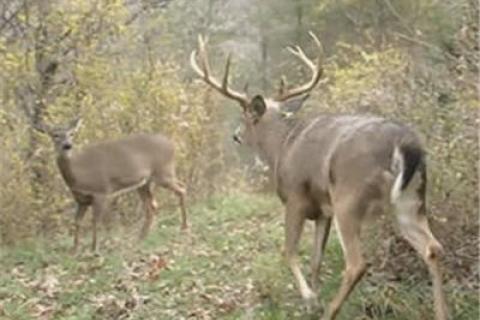
Article by Craig Dougherty
It’s hard to imagine any deer behavior generating more interest among hunters than the whitetail rut. It is also hard to come up with any behavior more capable of influencing prospects for hunting success and yet be so widely misunderstood. While our understanding of the rut is evolving annually, most hunters continue to think of it as being punctual, universal, and easily defined. Recent study indicates that it is none of those.
 |
| Photo of deer courtesy of Bass Pro Shops. |
For decades, writers and whitetail experts have advanced the notion of rut stages. According to most so-called gurus, the rut progresses through a set of behavioral phases or stages, which unfold in a more or less orderly fashion among an entire region’s deer herd. These stages are typically labeled with one-word descriptors with models having up to six phases. To listen to some accounts, at any given time on any given day, all the bucks in an area will be chasing does or rubbing trees or breeding or exhibiting some other predictable behavior associated with the rut. That is not what’s happening in the woods.
For the past five years or so, my son Neil and I have been circulating a rut-tracking report, which goes out to thousands of serious deer hunters. As a result, we receive hundreds of reports each week of the season (September through December) representing thousands of data points. We are also in the woods every day (Neil as a practicing wildlife consultant and me as a hermit-hunter living on a mountain). We hunt whitetails almost every day of our season and we have access to an amazing deer-hunting laboratory (see “The Whitetail Lab”), which allows us to observe upwards of 600 acres of prime deer habitat, and usually a dozen or so different deer, at any given time. And what we’ve learned is that the rut is anything but orderly.
The Hunter’s Peak
Ask most hunters to define the peak of the rut, and they will say something about when does are being bred. Drill down a little deeper and they will regale you with tales about bucks marching by treestands every hour on the hour, a dozen buck sightings in a single day, increases in mature buck sightings, and roaming gangs of bucks chasing frantic does. Problem is, while most hunters associate the peak of the rut with breeding, the behaviors they are actually describing are more associated with pre-breeding. Rarely, for example, do they mention anything about seeing bucks breeding or even tending does (being highly attentive, licking flanks, partial mounting, bedding with, etc.). Their working definition of the peak of the rut is all about action and seeing bucks. For all intents and purposes, it should be referred to as the “hunter’s peak.”
The Biological Peak of the Rut
Now, mention peak of the rut to a biologist or anyone else who keeps track of breeding dates, and you’ll learn that the true peak occurs when actual physical breeding is taking place or on those days when the most fawns are conceived. This biological peak of the rut is not necessarily a period of high activity in the woods (that comes earlier). Our review of between 80,000 and 100,000 photos each year confirms it. Buck sightings and photo counts are quite low during the breeding period, or the biological peak of the rut.
Are we splitting linguistic hairs over the rut? I don’t think so. Getting the rut right is the single most important thing a whitetail hunter can do to improve his chances of success. Understanding the difference between the hunter’s peak and the biological peak can mean the difference between the best week of hunting you’ve ever had and just another week in the woods.
Originally published on the OutdoorLife Big Buck Zone Blogs: How to Hunt the Rut
Published here with permission from Field & Stream
Related OutdoorLife Big Buck Zone Blogs:
Kentucky Takes Top Spot in New Whitetail Scale
How to Take a Good Trophy Shot
When to Move Your Stand
- 3929 views

